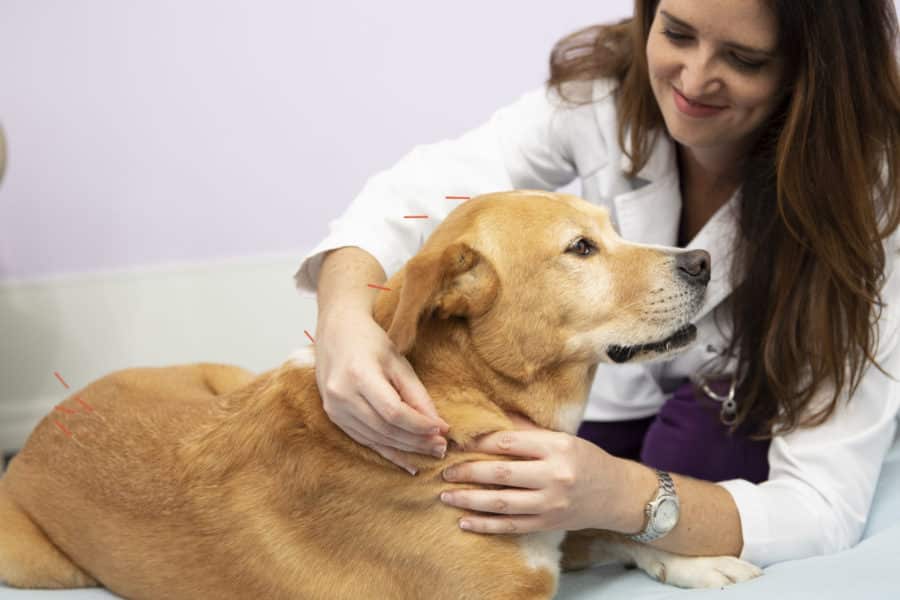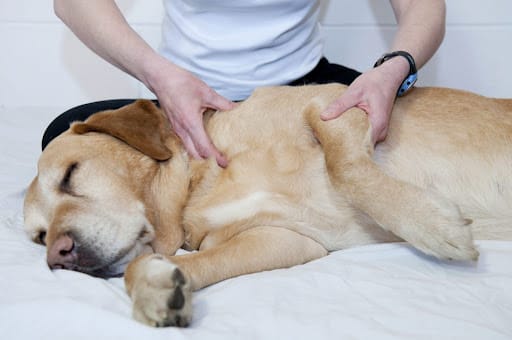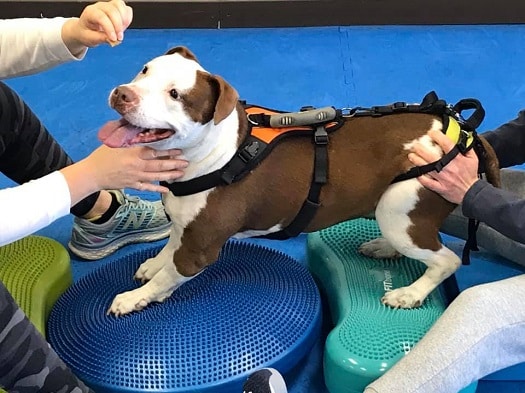Table of Contents
The area of canine rehabilitation has been increasingly well-known in recent years as a successful way to improve your dog health and wellbeing. Physical therapy may help dogs with a variety of musculoskeletal problems, help them heal from injuries, and generally improve their quality of life just like it can help people. We will go into the field of dog physical therapy in this detailed guide, going over its advantages, methods, case studies, certification requirements, and at-home applications.
Lets have a quick view on Bubble Theory Dog Training.
Unlocking the Benefits of Canine Physical Therapy

Dog physical therapy includes a variety of methods and exercises designed to lessen discomfort and increase range of motion. Optimizing a dog’s health through specific physical activity is one of the main advantages. Physical therapy can be quite helpful in promoting recovery and regaining function, regardless of the injury, whether it’s a chronic issue affecting the head and neck or an accident to the hind legs.
Techniques and Exercises
Range-of-motion exercises are an essential component of canine physical therapy. By preserving or regaining joint flexibility, these motions improve mobility and reduce stiffness. Dogs’ range of motion can be enhanced with exercises such as slow, controlled leash walks and mild side-to-side stretches. These exercises with your pet improve mobility.
Electrical stimulation is another useful method for inducing and relieving muscular contractions. This method is very helpful for dogs healing from orthopedic surgery or managing long-term medical issues. When combined with other physical therapy treatments, such as therapeutic exercise, it may speed up the healing process and improve results.
Improving Coordination and Balance

Enhancing a dog’s balance and coordination is a major goal of many physical therapy activities, particularly for those with neurological conditions or weak hind legs. Therapists can use balance boards and chest straps to test a dog’s ability to stay stable while doing different exercises. These activities can help them become more balanced over time and lower their chance of accidents or falls.
Case Studies
Case studies offer important insights into how effective dog physical therapy is. Take Max, a Labrador Retriever recovering from an injury to his hind limb. Within a few months, Max regained mobility and resumed his busy lifestyle due to a personalized rehabilitation therapy program that included electrical stimulation and therapeutic exercises.
Comparably, senior dog Bella, suffering from joint pain, found considerable relief from personalized physical therapy sessions. Bella’s quality of life significantly improved with pain-relieving modalities and range-of-motion exercises, enabling her to resume enjoying walks with her owner.
Accessibility and Certification Programs
The need for licensed physical therapists with a focus on dog rehabilitation is growing as canine rehabilitation gains more acceptance. Fortunately, veterinary professionals who wish to specialize in this area can now choose from a number of certification programs. This implies that more pet owners will have access to licensed professionals who can offer their animal friends physical therapy treatments.
Dog Physical Therapy at Home
There are choices for at-home dog physical treatment and various physical therapy sessions in specialty facilities. Pet owners can learn exercises and procedures under the careful supervision of licensed professionals, all in the comfort of their own homes. This improves convenience while strengthening the relationship between the owner and their canine friend.

Exploring Advanced Techniques and Exercises in Canine Physical Therapy
In addition to the benefits already discussed, dog physical therapy employs a wide range of additional exercises and techniques. Among these is hydrotherapy, in which dogs engage in joint-sparing activities in the water while building muscle strength through increased resistance. Another helpful tool is treadmill therapy, which is especially beneficial for dogs who are recovering from surgery or have movement problems. Therapists can modify the exercise to fit the demands of each dog by adjusting the inclination and speed.
Furthermore, proprioceptive training is essential for the rehabilitation of dogs who struggle with balance and coordination. These exercises test the dog’s awareness of body position and movement to assist in restoring stability and confidence. Wobble boards and balancing discs are typical equipment used in proprioceptive training exercises.
Discovering Pain Relief Methods
A key component of dog physical therapy is pain management, which uses various methods to reduce suffering and encourage healing. To target certain regions of pain and inflammation, therapists may also use cold laser treatment, acupressure, massage, and electrical stimulation. In addition to offering alleviation, these methods promote tissue repair and blood flow, hastening the healing process.
Taking Care of Certain Conditions
Dog physical therapy is quite flexible and may treat a variety of ailments and wounds. Therapists customize their approach to each dog’s unique needs, whether helping with weight loss, controlling arthritis, or post-operative care. Exercises, modalities, and lifestyle modifications may be incorporated into individualized therapy plans to maximize results and enhance general wellbeing.
Explore the The 9 Best Ways to Exercise With Your Dog.
Encouraging Preventative Care and Long-Term Health
Physical therapy has advantages beyond helping people heal from illnesses or injuries, even though it is frequently linked to rehabilitation. Frequent visits to the physical therapist can also act as preventative care, assisting in the early detection and treatment of certain problems. Therapists can monitor a dog’s movement patterns, muscular strength, and joint health, and they can then take early action to prevent injuries and preserve optimal performance.
Promoting Mental Wellbeing:

Dog physical therapy is a major factor in helping our furry friends’ mental health Encouraging Mental Well-Beyond the physical advantages, Dogs receive not only physical relief but also brain stimulation and engagement from the customized exercises and activities. This feature is especially important for older dogs or dogs that are healing from traumatic events since it lowers stress, anxiety, and boredom while raising general happiness and contentment. For dogs, particularly in their later years, mental stimulation through physical therapy activities can additionally stave off memory loss and provide them a feeling of purpose. Dogs have longer, more satisfying lives because they keep their minds active and mentally sharp by taking on different challenges and work.
Strengthening the Relationship:
Attending physical therapy sessions, whether at home or with a certified expert, helps to improve the relationship between dogs and their owners. Owners have a better understanding of their dog’s needs, behaviors, and skills by actively participating in their pet’s recovery process. Through this common experience, trust, communication, and companionship develop, resulting in the development of a mutually beneficial relationship based on support, care, and achievements. Additionally, because physical therapy sessions include collaboration, the emotional bond between dog owners and their pets is reinforced as they work together to enhance the dog’s health and quality of life. This connection strengthens daily encounters and leaves long-lasting impressions of resilience, willpower, and love. It goes beyond the treatment sessions.
Conclusion:
To sum up, dog physical therapy provides a comprehensive strategy for improving the health and wellbeing of our furry companions. Its effects are extensive, from pain relief and increased mobility to enhancing balance and averting more problems. Physical therapy offers various methods, modalities, and customized programs to address the needs of dogs with various diseases, breeds, and ages. Dogs can profit immensely from the individualized care and attention given by licensed physical therapists, whether in a professional setting or the convenience of their own home. As our knowledge of canine rehabilitation advances, it can also enhance the quality of life for our cherished canine companions.

